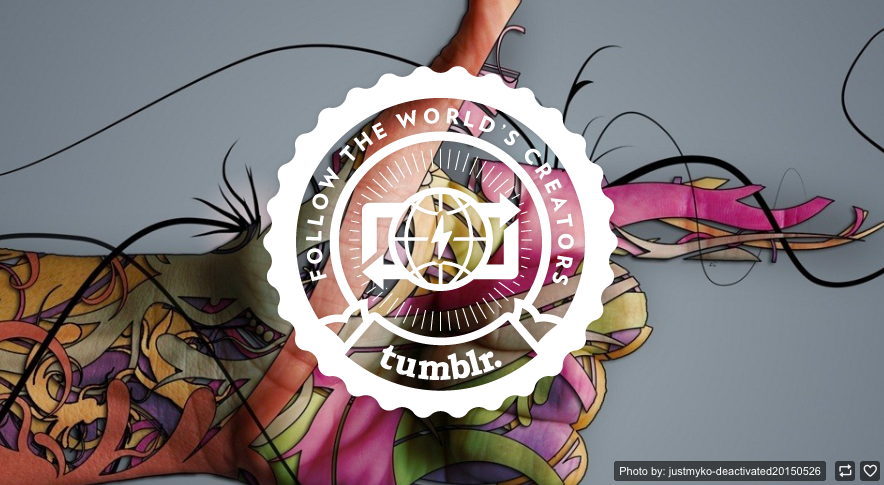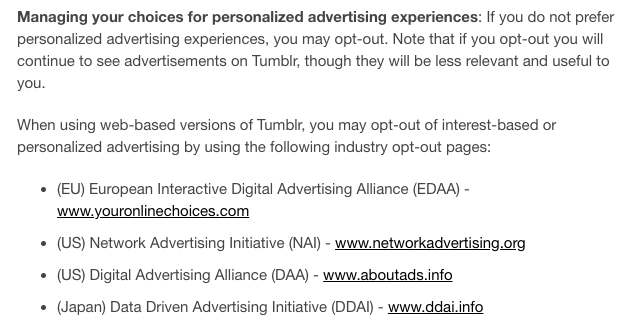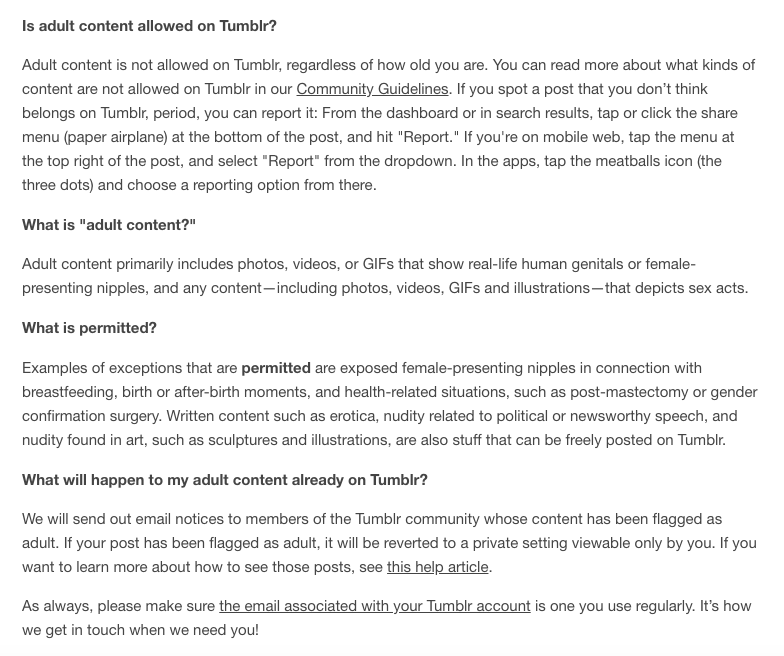
The self-identified blogging platform Tumblr was founded February 1st of 2007 by David Karp. Tumblr combines video, text, photo, audio, and GIFs, allowing users to both post their own content and “reblog” content they enjoy. This function of the site enables users to easily put something that they saw on their dashboard onto their own blog, thus allowing users to customize their blogs by choosing what they repost to their profile, the original content they share, and the capacity to customize the layout of their blog. This paper will take a look at the history and evolution of Tumblr as a platform, including the platforms affordances. At the same time this paper also seeks to investigate the platform’s limitations surrounding what content has been deemed acceptable.

David Karp created Tumblr based on a “form of blogging called ‘tumblelogging’, originally invented by German high school student Chris Neukirchen” (Clement). Neukirchen’s site ‘Anarchaia’ inspired Americans Marcel Molina and Sam Stephenson, the creators of Projectionist (Clement). These sites “served as visual inspiration for Karp and he ended up combining the two sites to create tumblr” (Clement). As a source of micro-blogging Tumblr defines its platform as a digital space where “your interests connect you with your people” (Tumblr.Inc, a). To provide such a service, Tumblr identifies three affordances; “express yourself,” “be yourself,” and “connect with your people” (Tumblr.Inc, a). The first affordance refers to Tumblr’s content consolidation. In the form of “text, photos, GIFs, videos, live videos, audio, anything” (Tumblr.Inc, a), Tumblr provides users a platform to share content by following blogs and being discoverable through one’s personal blog. Secondly, with the ability to customize all aspects of their blog, Tumblr allows users to be themselves. With access to an easily understandable coding system, users can customize “colors, fonts, layout, everything” (Tumblr.Inc, a). The final affordance of Tumblr manifests through the tags feature. With the ability to navigate through their preferred content; users become part of communities and start conversations.
As Tumblr continued to gain traction, the platform did not remain solely in the hands of Karp. As the site continued to grow past three hundred million monthly users, Yahoo announced their 1.1-billion-dollar purchase of the site in May 2013 (Isidore, 2013). Yahoo assured that Tumblr would be “independently operated as a separate business with Karp staying on as CEO” (Isidore, 2013). However, four years after this acquisition, Karp departed Tumblr due to “personal ambitions” and left the site to COO (now current CEO) Jeff D’Onofrio (Lunden, 2017). This same year, Verizon became the owners of Tumblr as part of their Yahoo acquisition (Rodriguez, 2019). In Tumblr’s most recent history, Verizon sold the website to Automattic, the owner of blogging site WordPress (Rodriguez, 2019). As Automattic acquired both the website and Tumblr’s staff, CEO Matt Mullenweg wrote on his Tumblr blog that he believes that Tumblr and WordPress are “philosophically aligned” and promised to “preserve the passion and sense of community” established by Tumblr (Mullenweg, 2019). Since then, the platform has continued to honour their core affordances of expression and connection.
The micro-blogging capabilities of Tumblr are “aimed at penetrating a particular online activity with their coding technologies” (Dijck, 2013, p.7). This penetration manifests as users become their own platform creators as they are in control of what they see while also coding their own blogs. Tumblr’s particularity of allowing users to customize their online experience “has been central […] among youth, especially girls, people of color, and LGBTQ-identified fans” (McCracken, 2017, p.151) as the site provides a community base. The presupposition of Tumblr’s users as young people coincides with the platform’s affordance to navigate amongst different communities as these young people are in the process of exploring their developing identity. In order to explore these connections amongst users, Tumblr has made their platform“‘participatory,’ ‘user centered,’ and ‘collaborative’” (Dijck, 2013, p.10). The technology involved in Tumblr’s user centered interface, begins with a “user’s reblogged post (with any likes or comments or hashtags they add) [which] goes back into the general dash feed, but it also goes to the user’s personal [blog]” (McCracken, 2017, p.154). A users’ blog functions as a “diary” where users create original material and reblogging others’ material (McCracken, 2017, p.154). This participatory nature between Tumblr users producing content while also sharing content, navigates into the social relationship of the platform.

Similar to that way Turkle (1994) describes the experience of partaking in role playing games, Tumblr “enable[s] people to work through issues of identity” (p.3). With the affordance to be who they want to be and explore communities they feel a part of, the site “becomes a play space for thinking about the real world” (Turkle, 1994, p.10). As McCracken (2017) explains that Tumblr been central in the lives of minority groups (p.151), they use this platform to navigate the world beyond their struggles. Instead, Tumblr provides a space where these people can come together socially and engage in discourse with those in similar situations. These communities can thus begin to establish resistance they can later bring into the real world. The social aspects of Tumblr and the way in which users are free to customize their platform experience is directly in line with the political implications of the social media site.

By allowing users, nearly complete, free reign over what they post, Tumblr has essentially democratized its platform. The participation amidst users does not distinguish an “algorithmic hierarchy” where users are valued based on their popularity in terms of following (McCracken, 2017, p.155). The origins of Tumblr posts are obscured, and users are not quantified based on the amount of likes or relogs their content receives. In turn, “users are not automatically marginalized or disparaged because of their age or unpopular opinions” and are “able to hide gender, national, religious, and racial designations” which are otherwise markers for discrimination on other platforms (McCracken, 2017, p.155).

Amidst the proponents for identity, the platform must make money. In order for Tumblr to provide these services to their users, they must be profitable. As such, Tumblr run ads. Dijck (2013) explains this economic implication “as the collar of a political economy deeply rooted in audience commonization” (p.17). Automattic, works with “online advertising companies to provide [users] with advertising that is as relevant and useful as possible” and in order to do so they “make educated guesses about interests based on [their] activity on [Tumblr’s] sites and services” (Tumblr.Inc, a). These ads are in direct responses to what a user engages with on the platform. Although Tumblr allows users to opt-out of these personalized ads, the platform still must run ads in order to provide their services to users for free.

Despite the value in customization and community building, users have experienced limitations in this practice. In December 2018, Tumblr took the step to no longer allow adult content on their platform (Duguay, 2018, para.1). Adult content, as defined by Tumblr, “includes photos, videos, or GIFs that show real-life human genitals or female-presenting nipples, and any content—including photos, videos, GIFs and illustrations—that depicts sex acts” (Tumblr.Inc, b). This change in policy created a fragile dichotomy for Tumblr users. On one hand it forced degrading, scary, violent… content off of the platform, the other side saw the limitations in platform’s algorithm to identify adult content. Which meant many identities being eliminated from the digital system they built a community in. Trans users were amongst those most affected. Haimson, Dame-Griff, Capello, and Richter (2019) explain that “Trans people use Tumblr to post content related to their transitions—much of which Tumblr’s algorithms classify as ‘adult’” (p.1). Tumblr’s colloquially called “porn block” has had a serious impact on trans users as their content that is labeled “adult” on the platform is often educational in their community and a way to document their personal transition (Haimson, et al. 2019, p.2). Turkle (1994) identifies an ‘ego ideal’ in role playing games where players “embodying aspects of themselves that they hate or fear or perhaps have not ever consciously confronted before” (p.7). Not only is Tumblr’s porn block detrimental to trans users sharing their experiences, it also eliminates the tool of education that aid users beginning to confront identities they may have never confronted. With Tumblr having been marketed to users as a site where one can be themselves and develop a community with others, this platform policy severely limits trans users this ability. The ban also limits to social interactions between those educating themselves on trans identity.

Dijck (2013) explains that “platform managements [has] to walk a tightrope between growth scenario – luring more customers to sites – and pleasing its original, often assertive, users, who [are] keenly aware of the value they added to the site’s market position” (p.15). By enforcing the ban on adult content, Tumblr has attempted to create a social media environment that appeals to all. However, in their attempts to frame the platform as a space free of sex acts and nudity, Tumblr instills an ideal that sexuality should remain hidden. With Tumblr’s adult content algorithm including photos of transitioning people in their definition of “sexual acts” they put for the societal idea that transition is dirty and should not be seen, despite the education and identity formation is provides.
In conclusion, Tumblr facilitates engagement with by providing an extensive array of communities that users can partake in. Through the customization of one’s blog and the ability to navigate through and post the content they feel connected to, users have free reign to develop communities. This community building is most importantly amongst minority groups which other social media sites may not favour. However, the customization does come at a cost where Tumblr policy eliminates this sense of community for people who do not fit into the platforms’ goal to appeal to wider markets.
Works Cited
Clement, M. (n.d.) tumblr: History in the Making. The Web History Project. Retrieved from http://www.thewebhistoryproject.com/tumblr/
Dijck, J. van. (2013). Engineering Sociality in a Culture of Connectivity. In The Culture of Connectivity: A Critical History of Social Media (pp. 3–23). Oxford ; New York: Oxford University Press.
Duguay, S. (2018, December 6). Why Tumblr’s ban on adult content is bad for LGBTQ youth. The Conversation. Retrieved from https://theconversation.com/why-tumblrs-ban-on-adult-content-is-bad-for-lgbtq-youth-108215
Haimson, O. L., Dame-Griff, A., Capello, E., & Richter, Z. (2019). Tumblr was a trans technology: the meaning, importance, history, and future of trans technologies. Feminist Media Studies, 1-17.
Isidore, C. (2013, May 20). Yahoo buys Tumblr, promises to not ‘screw it up’. CNN Business. Retrieved from https://money.cnn.com/2013/05/20/technology/yahoo-buys-tumblr/index.html
Lunden, I. (2017, November 27). David Karp is leaving Tumblr by the end of the year. TechCrunch. Retrieved from https://techcrunch.com/2017/11/27/david-karp-is-leaving-tumblr-by-the-end-of-the-year/
McCracken, A. (2017). Tumblr youth subcultures and media engagement. Cinema Journal, 57(1), 151-161.
Mullenweg, M. (2019, August 12). Automattic + Tumblr. Matt on Tumblr. Retrieved from https://photomatt.tumblr.com/post/186964618222/automattic-tumblr
Rodriguez, S. (2019, August 12). Verizon sells Tumblr to Wordpress owner six years after Yahoo bought it for $1.1 billion. CNBC. Retrieved from https://www.cnbc.com/2019/08/12/verizon-sells-tumblr-to-wordpress-owner-six-years-1point1-billion-deal.html
Turkle, S. (1994). Constructions and reconstructions of self in virtual reality: Playing in the MUDs. Mind, Culture, and Activity, 1(3), 158–167.
Tumblr.Inc. (a) About. Retrieved from https://www.tumblr.com/about
Tumblr.Inc. (b) Adult Content. Retrieved from https://tumblr.zendesk.com/hc/en-us/articles/231885248-Sensitive-content

0 comments on “Tumblr: A Source of Community… Most of the Time”